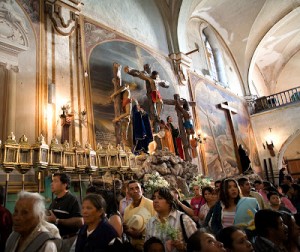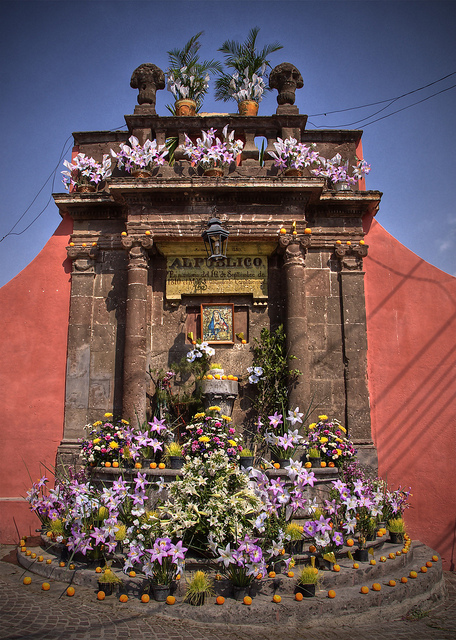Friday April 12 th
5pm
Children’s Stations of the Cross
San Antonio
Follow the story of Crucifixion with children playing all the parts as they go through San
Antonio on Friday April 12 th starting at 5PM from the San Antonio church.
Friday April 12 th
6pm to midnight
Across town
Altars to Mary at Crucifixion
Viewers experience Jesus death less from his dying and more towards her perspective
of being left behind alone.

The Friday before Good Friday is for Our Lady of Sorrows. It acknowledges Mary’s
seven sorrows stretching from Jesus’ presentation at the temple and culminate in her
pain at losing her only child. Altars throughout town contain symbolic elements of
mourning such as sour oranges, chamomile, wheat and purple cloth. Bitter oranges
represent Mary’s sorrow and gold is place on the oranges representing Mary’s tears.
The wheat (grown in darkness and light gold of color) represent Jesus’ secret of
knowing a horrible death awaited him and is what communion bread is made from.
Chamomile is for humility. Purple, in addition to mourning, represents royalty since
Mary is Queen of Heaven. The white clothes and flowers are for Mary’s purity.
Also chilacayote, a kind of sweet pumpkin, represents the sweetness of Mary’s maternal
love for Jesus. Along with other flavored waters the chilacayote is frozen into popsicles
representing Mary’s tears changed into something good. It is also the motivation for
children (and the child-like) to view as many altars and receive as many popsicles as
possible!
Many altars will play the music of the Tenebrae. This haunting composition was by
Juan Gutierrez de Padilla especially for San Miguel’s Easter season in the mid 1600’s.
In Colonial times there were 300 factories run by the indigenous and 50 by the Spanish
making fabrics like we see today in multicolored napkins for sale in San Miguel. Our
Lady of Sorrows was the patroness of these workers whose work was centered around
the street called Baranca. Near there, on Piedras Chinas, a small chapel was built in
her honor her seven sorrows. Tonight the chapel is open and surrounding area filled
with altars and street vendors providing food and drink.
The altars are constructed all day with visitors strolling to visit between 6PM and
midnight.

Palm Sunday April 14 th
11AM
Parque Juares to the Parroquia
Procession
View Jesus joyful entry into town a few days before he is crucified on Palm Sunday April
14 th at 11AM heading from Parque Juares to the Parroquia.
For Palm Sunday vendors will be selling beautiful items made of hand woven palm
fronds in front of all the main churches today. Some of the best are sold at the Oratorio.
Christ on the donkey is a medium-sized statue from the Santa Escuela Church, beside
the Parroquia. Preceded by dancers in their bright regalia and trailing feathers and
followed by hundreds of participants waving palm fronds, the procession circles back to
the Jardín amid the sound of drums, trumpets and church bells.
Palm Sunday April 14 th
Various Times across town
Blessing of the Palms
The blessing the palms occur with corresponding processions across town. 6:15AM is
at the Chapel of Good Health on Plaza Civica, 9AM is in the atrium of the Immaculate
Conception and 11:45 at San Antonio.
Wednesday April 17 th
Various times and locations
Processions
Wednesday of Holy Week recalls the abandonment of Jesus with early evening services
called Vespers of Darkness. A special mass with a candelabra on the altar holds 15
candles. One candle is extinguished for each Psalm sung until finally, as the service
ends, a single candle remains, representing Christ alone in the garden.
Following is a procession to follow the Stations of the Cross build into San Miguel’s
streets started by Father Philip Neri Alfaro. The niches start at the Santa Escuela
(beside the Parroquia), run by St. Francis and end at the Chapel of Calvary, named for
the hill Jesus died on.
At 5PM are processions from both the Oratorio and San Juan de Dios. At 6PM they
start from the Santa Esculea next to the Parroquia.
Holy Thursday April 18 th
Across town, staring at 6PM
Visiting 7 Churches
Following an ancient San Miguel tradition, people visit seven churches today to view
special altars depicting Jesus before his death and eat various types of bread. The
lines to enter can be very long, so visiting any seven can take some time. Luckily
outside any church are food vendors.
Holy Thursday commemorates several important events of Holy Week (Santa Semana)
with masses including the Last Supper, the washing of the feet of the 12 Apostles and
the arrest of Jesus. The perfume of chamomile is characteristic in every church.
The act of visiting seven churches reinforces the solemnity of the week and San
Miguel’s observance of this most holy time. Today the faithful visit churches in any
sequence or location they choose. Historically one left the Temple of Good Health to go
to Santo Domingo to correspond with St. Peter’s in Rome. Then came the Church of
the Third Order of St. Francis, the Parroquia, the Nuns’ Church (Las Monjas), San Juan
de Dios, Santa Ana and San Francisco. Lastly a visit was paid to the Casa of Loreto in
the Oratory in honor of early Roman church called Vallicella , the first church started
by St. Phillip Neri, founder of the Oratory clergy.
Each church will display parts of the Crucifixion story. Seven churches are chosen to
reflect Jesus’ last words of “Forgive them, Father, for they know not what they do.”

Good Friday April 19 th
Stations of the Cross
Various times and locations
The telling of the crucifixion story, or Stations of the Cross, are performed across town
at various times and locations. 6AM at the Santa Escuela, next to the Parroquia. 9AM
from San Juan de Dios, 10AM in in San Antonio and 10:30 in the streets surrounding
the Oratorio.
During Holy Week are countless processions devoted to depicting Jesus’ death. One of
the oldest, that started in Colonial times, follows the route of the Stations of the Cross
built into the buildings of San Miguel. The stations start from the Santa Escuela (next to
the Parroquia) and continue on the streets of Juarez, Mesones, Nunez and San
Francisco to end at the tiny chapel of Calvary on the corner of Real de Queretaro and
Calvario. Inside the chapel is the image of Jesus with painful anxiety on his face for his
forlorn solitude.
Stations of the Cross (sometimes referred to as Way of the Cross or Via Crucis) refer to
a series of artistic representations depicting Christ carrying the cross to his crucifixion.
Churches typically place Stations of the Cross at intervals along the side walls and are
reflective of the artistic culture where the church is located. The tradition of moving
around the Stations to commemorate the passion of Christ began with St. Francis of
Assisi. It is most commonly done during Lent, especially on Good Friday.
The object of the Stations is to help the faithful to make a spiritual pilgrimage of prayer,
through meditating upon the chief scenes of Christ’s sufferings and death. It has
become one of the most popular devotions for Roman Catholics.
Traditionally there were 14 Stations of the Cross, but Pope John Paul II added the
Resurrection as the fifteenth.

The stations are:
First Station: Jesus is condemned to death.
Second Station: Jesus carries the cross.
Third Station: Jesus falls the first time.
Fourth Station: Jesus meets his mother Mary.
Fifth Station: Simon of Cyrene helps Jesus carry the cross.
Sixth Station: Veronica wipes the face of Jesus.
Seventh Station: Jesus falls the second time.
Eighth Station: Jesus meets the women of Jerusalem.
Ninth Station: Jesus falls the third time.
Tenth Station: Jesus is stripped of his garments.
Eleventh Station: Jesus is nailed to the cross.
Twelfth Station: Jesus dies on the cross.
Thirteenth Station: Jesus is taken down from the cross and laid in the arms of Mary,
his mother.
Fourteenth Station: Jesus is buried.
Fifteenth Station: Resurrection
In many of the ingenious chapels surrounding town the Stations of the Cross are
marked in the front courtyard of the church for it was outside that the indigenous
preferred to worship.
Good Friday April 19 th
The Encounter Procession
Noon from Santa Escuela
The encounter of Jesus with the Virgin Mother on the road to Mount Calvary during the
Stations of the Cross that takes place in several streets surrounding the jardin. Upon
seeing his mother, the ancient statue of Jesus actually bows his head in sorrow.
Others featured in the processions are Jesus’ friends St. John the Apostle, St. Mary
Magdalene, and St. Veronica with her veil displaying Jesus’ face. Normally Jesus’
aunt, Mary of Clopas is seen. Also featured are Gestas and the young St. Dismas, the
bad and good thieves who died alongside Jesus. Numerous nameless angels
represent comfort sent from heaven to aid Mary in her sadness.
St. Roque leads the procession followed by angels and 12 barefoot men wearing
roughly woven garments with crowns of thorns on their heads. Next 12 men carry skulls
represent the path from death to eternal life. All are guarded by Roman soldiers.
Twelve men carry the statue of Eccehomo with the parish priest carrying an ancient
cross used since the 1700’s.
Good Friday April 19 th
The Holy Burial
5PM from the Oratorio
The Holy Burial procession starting and ending at the Oratorio of San Felipe Neri church
began in 1712. It begins with groups of women, all dressed in black and high heels,
carring flowers and statues of saints. Then young girls in white with feathered angel
wings join the parade carrying images of the Passion like nails, crown of thorns, the
ladder, the cock, the sponge with vinegar and the dice used by the Romans to gamble
for Christ’s clothes. Also the pitcher and bowl with which Pontus Pilate washed his
hands is included.
Next are the elegant and colorful statues of the saints and a glass-coffin Jesus with
indigenous features, whom emerge from the church on only this one day each year.

The life-sized figures are carried on platforms and normally head towards the jardin. Other
years the procession stays in Plaza Civica.
Angels emerge in to the streets carrying the crown of thorns, the spikes, the sword and
Veronica’s veil. Their role is to elicit compassion from the viewing public while assisting
Mary with her grief.
An organization called Esclavitud Lauretana bring the image of Mary in a long velvet
cloak which will spend Holy Saturday in the Santa Casa de Loreto awaiting visitors to
keep her company in this time of mourning.
The last images to emerge are of Nicodemus and Joseph of Arimathea, who carries a
document where Pontius Pilate authorizes him to take Christ down form the cross and
bury him. They are surrounded by Roman soldiers to insure Jesus’ body does not get
stolen, as Pontius Pilate ordered.
Symbolically the procession returns at sunset when there is only mourning and
sadness. Youth choirs sing songs of pain as the voices of the innocents, as pleas to
God written exclusively for this event.
There are other popular processions and reenactments in Colonia San Luis Rey
and Atotonilco.
Holy Saturday April 20 th
Our Lady of Solitude
All day
Holy Saturday in San Miguel is mostly quiet as the city waits for the joy of the
Resurrection on Easter Sunday, when the events of Holy Week will come to an end.
This quiet day is the feast of Our Lady of Solitude, a patroness of San Miguel since
1555.
Today the Benedictine Cloister just outside of San Miguel is named in her honor.
Historically no mass or communion is offered on this day unless the person is near
death. Then the only hosts available are at the Immaculate Conception church with the
cloistered sisters. Instead wakes are held in the churches with rosaries being recited to
ease Mary’s pain while keeping her company.
Easter Sunday April 21st
The Jardin
Noon
Easter is a celebration of Jesus’ resurrection featuring huge piñatas that explode over
the jardin. The piñatas feature politicians, Judas and celebrities not in good public favor
whose dismembered paper body parts are quickly gathered by local children and sold to
visitors.
It is an emotional release of all the solemnity surrounding the time leading up
to Easter and an exciting celebration of Jesus’ resurrection.
Officially Easter begins Saturday night. Many will attend a wake for Jesus, go home for
a large dinner and return for Easter mass at 9PM. The church may be engulfed in
darkness until one lit candle begins the moving transformation to a fully candle lit church
signifying Jesus’ resurrection.
Thursday April 25 th
Lord of the Column Procession
Midnight
The Lord of Column returns home from St. John of God to Atotonilco.
Joseph Toone is the Historical Society’s short-story award winning author of the SMA Secrets book series. All books in the series are Amazon bestsellers in Mexican Travel and Holidays. Toone is SMA’s expert and TripAdvisor’s top ranked historical tour guide telling the stories behind what we do in today’s SMA. Visit HistoryAndCultureWalkingTours.com, and JosephTooneTours.com.


